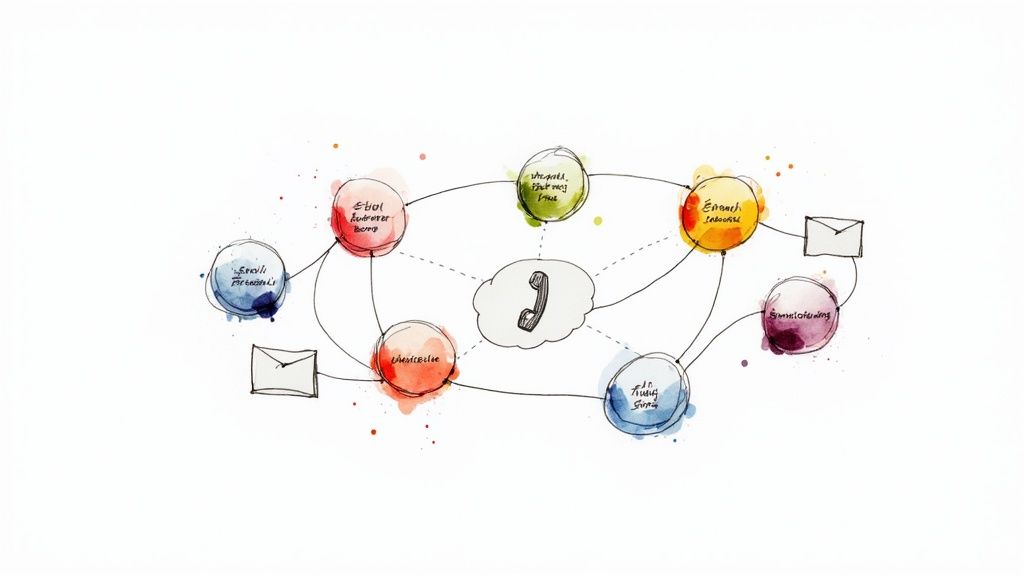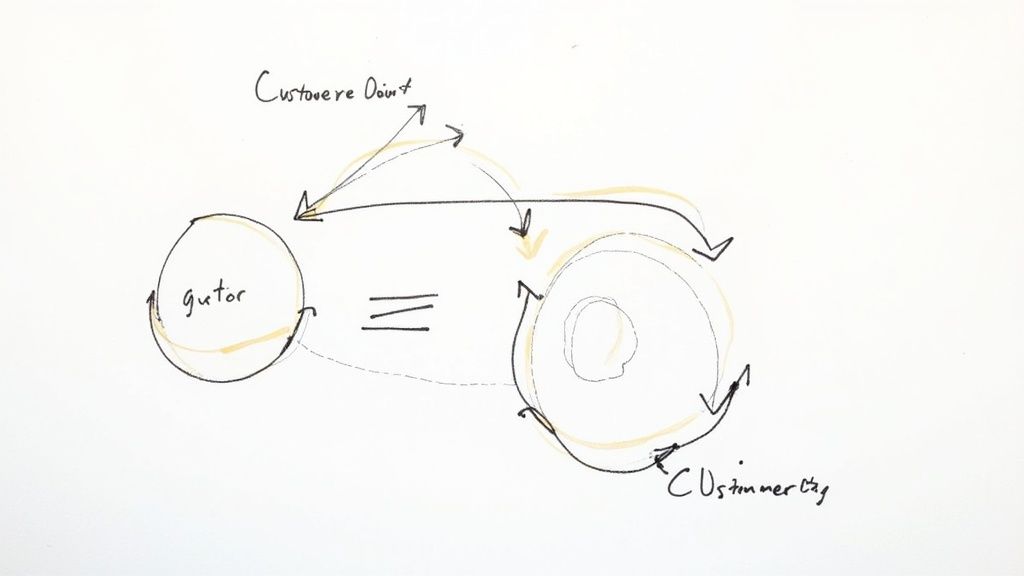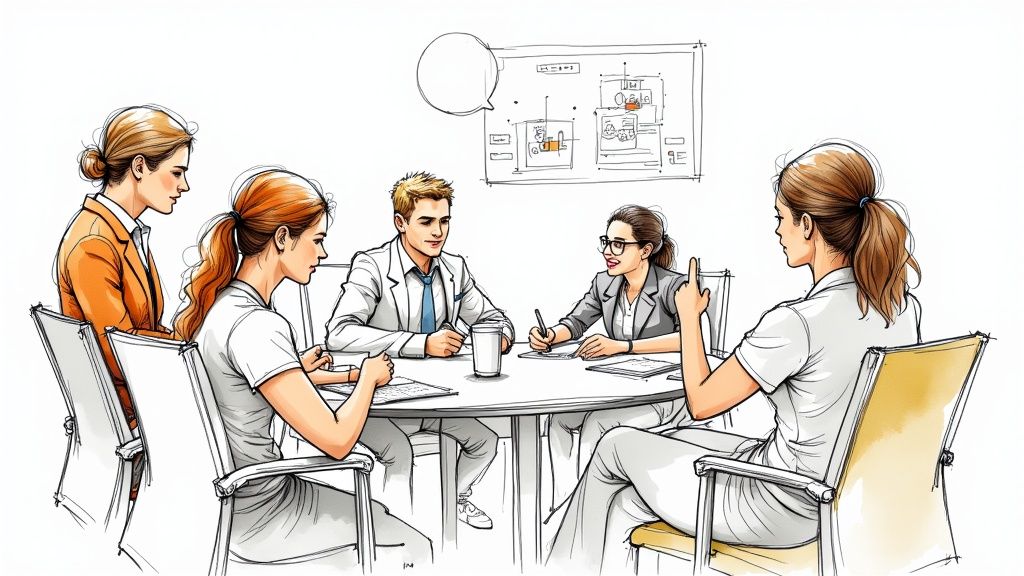Customer Service Communication: Build Loyalty Like a Pro
The Hidden Psychology of Customer Service Excellence

Great customer service goes far beyond just sharing information - it's about understanding what makes customers tick and building real connections. When service teams grasp the psychology behind customer behavior, they can move past robotic scripts to create meaningful interactions. Something as simple as saying "I hear how frustrated you are" can completely shift a tense conversation and open the door for genuine dialogue.
The Power of Empathy and Emotional Connection
At its core, exceptional customer service comes down to empathy. When customers truly feel understood and cared about, their satisfaction skyrockets. This makes perfect sense - empathy creates a shared experience that strengthens the relationship between customer and company. Even if you can't solve their problem right away, showing real concern builds trust that lasts. That's why the best service teams focus just as much on emotional awareness as technical knowledge.
Meeting Expectations and Building Trust
Clear communication and follow-through are essential for maintaining customer trust. Companies need to set realistic expectations and consistently deliver on their promises. For example, if you tell a customer their issue will be fixed within 24 hours, missing that deadline without explanation can seriously damage the relationship. But when you do what you say you'll do, customers learn they can count on you.
The Importance of Personalized Interactions
Personal touches make all the difference in customer service. In a world full of generic automated messages, taking time to use someone's name or reference their specific situation helps them feel valued. Mentioning past purchases or conversations shows you see them as more than just another ticket number. These small but meaningful gestures create lasting connections between customers and brands.
From Transactional to Transformative: Creating Memorable Experiences
The best customer service turns routine interactions into standout experiences. By understanding what drives customer satisfaction at a deeper level, companies can build the kind of trust and loyalty that keeps people coming back. When you focus on creating genuine human connections rather than just closing tickets, customers notice - and they tell others about it too.
Mastering the Art of Swift, Meaningful Responses

Every successful customer service team knows that speed and quality must work hand in hand. While quick responses keep customers happy, genuine personal connections build lasting relationships. Let's explore how top teams deliver both rapid and meaningful support that keeps customers coming back.
The 10-Minute Response Window: Why It Matters
Time matters deeply to customers reaching out for help. Research shows that 90% of people expect quick responses from customer service, with most defining "quick" as under 10 minutes. This short window has become the standard that shapes customer satisfaction. When companies miss this mark, customers often feel ignored and may take their business elsewhere. The message is clear - prompt responses show customers you value their time and business.
Optimizing Workflows for Speed Without Sacrificing Quality
Smart teams know that being fast doesn't mean cutting corners. They put systems in place to work efficiently while keeping interactions personal:
- Prioritizing Requests: Using tiered systems to handle urgent issues first ensures critical problems get immediate attention
- Knowledge Base Empowerment: Giving agents quick access to detailed information lets them answer common questions confidently
- Smart Routing: Directing questions to agents with the right expertise reduces back-and-forth and speeds up solutions
Tools and Techniques for Efficient Responses
Several key tools help teams stay both quick and thorough:
- Thoughtful Templates: Having pre-written answers for common questions saves time, but agents customize them to each situation
- Team Communication Tools: Quick chats with colleagues help agents find answers fast and get expert input when needed
- AI Chat Support: Tools like Sitebot can handle basic questions and gather initial details, freeing up agents for more complex issues while maintaining your brand voice
Building Team Capacity and Maintaining Quality
Great service starts with a well-supported team:
- Regular Training: Ongoing practice with products, communication, and empathy helps agents respond confidently
- Decision-Making Power: Letting agents solve problems independently speeds up help and builds customer trust
- Peak Period Planning: Having clear strategies for busy times keeps service smooth when volume spikes
These approaches help companies deliver quick responses that still feel personal and helpful. The goal is creating positive experiences that keep customers happy and loyal - not just answering fast, but answering well. When speed and quality come together, that's when customer service truly shines.
Creating Authentic Personalized Experiences at Scale
True personalization goes far beyond adding a customer's name to communications. It means understanding what each person needs and values, then shaping every interaction around those individual preferences. Many companies struggle with a key challenge: how to deliver this personal touch consistently while serving thousands or millions of customers? Let's explore practical ways to scale authentic personalization.
Gathering and Utilizing Customer Insights
The foundation of meaningful personalization is understanding your customers through data. This means tracking their journey - from past purchases and support tickets to browsing patterns and stated preferences. But collecting information is just the start. You need smart systems to organize these insights and make them instantly useful for your team.
Consider this common scenario: A customer reaches out about a recent purchase. When your support agent can quickly pull up their complete history, they immediately grasp the context and can jump straight to helping. The customer feels understood without having to repeat their story, creating a smoother, more personal experience.
Implementing Natural, Not Forced, Personalization
Good personalization feels like talking to a friend who knows you well - not a robot programmed to parrot your name. Focus on naturally weaving customer insights into genuine conversations that address their specific situation. Research shows this matters tremendously - 76% of customers get frustrated when interactions feel impersonal or scripted. They can tell the difference between authentic engagement and shallow automation.
Training for Consistent Personalized Experiences
Your customer service team needs both skills and tools to deliver personal experiences at scale. This means training them to:
- Quickly access and interpret customer data
- Adapt their communication style for different personalities
- Balance efficiency with meaningful connection
Support tools like Sitebot can help by handling routine questions through AI chat, giving your team more time for complex issues that need a human touch. This combination of skilled staff and smart technology helps you scale personalization without losing authenticity. When done right, this builds the kind of positive experiences that keep customers coming back.
Building a Seamless Multi-Channel Service Experience

Customers interact with businesses through multiple channels throughout their journey - from browsing social media and live chat to making phone calls and sending emails. This creates a significant challenge for companies trying to deliver consistent service across all these touchpoints. Getting it right matters - businesses that successfully connect these channels see customer satisfaction rates up to 23 times higher than those that don't. Let's explore how to create these seamless customer experiences.
Understanding the Omnichannel Landscape
Modern customers naturally move between different communication channels. Research shows that 73% of people use multiple channels during their purchase journey. A typical example is someone who discovers a product on social media, asks questions via website chat, and completes their purchase through email. This means businesses need to maintain consistent information and context across every platform where customers reach out for help.
Maintaining Consistent Quality Across Channels
Each communication channel has its own strengths and requirements. Email works well for detailed explanations, while chat needs quick, clear responses. Phone calls build personal connections, and social media requires careful public communication. To handle these differences effectively, support teams need thorough training on adapting their communication style for each platform. The goal is to deliver the same high-quality experience no matter how a customer chooses to connect.
Integrating Channels for a Seamless Experience
True multi-channel service requires more than just being available on different platforms - the channels need to work together smoothly. When a customer moves from chat to phone, they shouldn't have to repeat their story. This is where good CRM systems make a big difference by giving support agents a complete view of past interactions. For instance, when taking a call, agents can quickly check previous email conversations to understand the full context and skip asking redundant questions.
Managing Transitions Between Channels
Moving between channels is often where service breaks down - 68% of customers get frustrated when they're transferred between departments. The solution involves both customer-facing and internal improvements. Support teams need clear procedures for handoffs, shared access to customer information, and good tools for working together. Whenever possible, letting the same agent handle an issue across different channels creates a better experience. For example, if a chat conversation reveals the need for detailed troubleshooting, the agent should be able to smoothly switch to a phone call while keeping all the context from their chat discussion. This kind of connected service helps build customer trust and satisfaction.
Transforming Internal Communication for Better Customer Outcomes

Great customer service depends just as much on internal team communication as it does on customer interactions. When teams work well together behind the scenes, they create much better experiences for customers. Recent studies show that over 70% of customers expect different company departments to coordinate seamlessly on their behalf. This makes sense - solving complex problems requires multiple teams to work together effectively.
Breaking Down Silos for Enhanced Customer Experiences
One major barrier to good internal communication is when departments operate in isolation from each other. These divisions create bottlenecks that prevent teams from getting the information they need to help customers properly. Take a common scenario: a customer calls support about a billing issue that started with the sales team. If those departments aren't talking to each other, the customer ends up repeating their story multiple times as they get passed back and forth - a recipe for frustration. Getting rid of these barriers between teams is essential for serving customers well.
Streamlining Information Flow for Quicker Resolutions
Quick problem-solving requires smooth information sharing across the organization. This means putting systems in place that make it easy for different departments to collaborate on customer issues. For example, using a shared CRM system gives all relevant teams access to complete customer histories, including past conversations, purchases and ongoing problems. This shared knowledge helps agents provide more personal and efficient support. Simple tools like team chat platforms also let staff quickly check with colleagues, so customers spend less time waiting.
Creating Smooth Handoff Processes
Careful handoffs between departments are another key part of good internal communication. As noted earlier, 68% of customers hate having their calls transferred, especially if they must explain their issue again. To prevent this, companies need clear steps for passing customer interactions between teams. This includes detailed documentation, specific contact people in each department, and training on smooth transfers. Regular customer feedback can also help identify and fix problems in the handoff process.
Building Strong Inter-Departmental Relationships
Beyond formal systems, building real connections between departments is crucial for effective communication. Joint projects, training sessions and team events help foster collaboration. When teams understand each other's work and challenges, they communicate better and focus on shared goals. This directly improves the customer experience by reducing friction, speeding up solutions, and presenting a united front. Strong relationships between departments help staff handle complex issues more efficiently, avoid delays, and maintain consistent service quality. In the end, investing in better internal communication means investing in happier, more loyal customers.
Measuring What Matters: Beyond Basic Service Metrics
Great customer service relies on effective communication. But when it comes to measuring how well teams actually communicate, many organizations fall short. While metrics like Customer Satisfaction (CSAT) scores provide a starting point, they don't capture important details about how service interactions unfold. For example, a customer might report being satisfied simply because their issue was resolved, even if the communication along the way was confusing or impersonal. To truly understand and improve service quality, we need to look deeper.
Moving Beyond CSAT: A Holistic View of Communication
Smart organizations track multiple metrics to get a complete picture of their customer communication. Some key measures to consider:
- First Response Time: How quickly does your team initially respond to customer inquiries? Quick responses matter - studies show 90% of customers expect immediate replies. This metric directly shows if your team is being responsive.
- Resolution Time: While fast first responses help, customers ultimately care about getting their issues fixed. By tracking how long it takes to fully resolve issues, you can spot communication bottlenecks.
- Customer Effort Score (CES): This measures how much work customers had to do to get help. Good communication should make getting support feel easy and straightforward.
- Conversation Tone Analysis: New tools can analyze the emotional tone of customer conversations, helping identify patterns in how your team communicates. This reveals where agents may need coaching on more positive, helpful language.
Gathering Actionable Feedback: Listening to the Voice of the Customer
Simply asking "Are you satisfied?" won't give you the insights needed to improve. Instead, try these approaches to gather detailed feedback:
- Post-Interaction Surveys: Ask specific questions about how clear, empathetic and helpful the communication was, not just overall satisfaction.
- Qualitative Feedback: Give customers space to describe their experience in their own words through comment sections or follow-up emails. These details often reveal issues that numbers miss.
- Social Media Monitoring: Watch social channels for mentions of your customer service. This shows how people talk about their experiences when speaking freely.
Data-Driven Improvements: Turning Insights into Action
Measuring communication only matters if you use the data to get better. Once you understand how your team is doing, take action:
- Targeted Training: If tone analysis shows agents using negative language, provide coaching on empathy and positive communication.
- Process Optimization: When resolution times are high, examine your workflows to find and fix communication bottlenecks.
- Empowerment and Recognition: Celebrate agents who consistently communicate well to reinforce good practices across the team.
Using these measurement approaches helps you truly understand how effectively your team communicates with customers. You can spot potential issues early and keep improving your service approach. This leads to stronger customer relationships and better business results over time.
Boost your customer service communication with Sitebot, an AI chatbot platform that can handle routine inquiries, provide instant support, and free up your team to focus on more complex interactions. Learn more and start your free trial at Sitebot.


